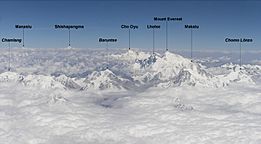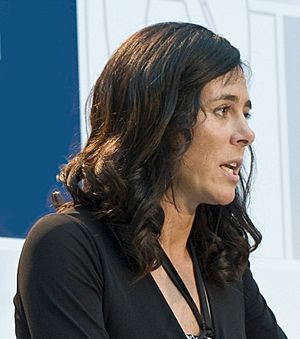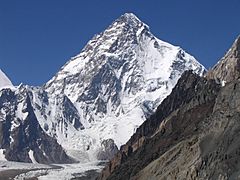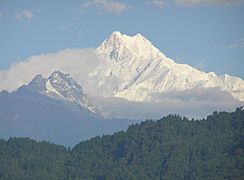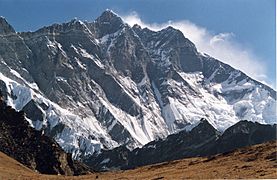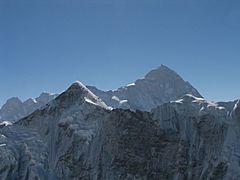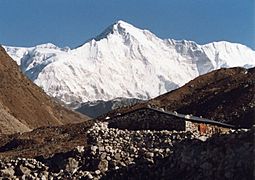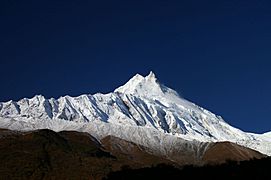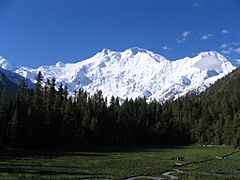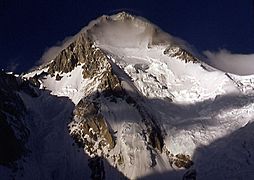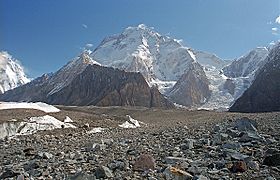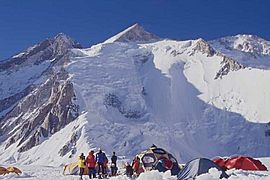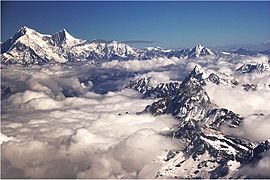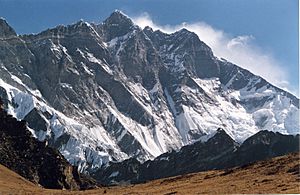Eight-thousander facts for kids
The International Mountaineering and Climbing Federation or UIAA recognises eight-thousanders as the 14 mountains that are more than 8,000 metres (26,247 ft) in height above sea level, and are considered to be sufficiently independent from neighbouring peaks. However, there is no precise definition of the criteria used to assess independence, and, since 2012, the UIAA has been involved in a process to consider whether the list should be expanded to 20 mountains. All eight-thousanders are located in the Himalayan and Karakoram mountain ranges in Asia, and their summits are in the death zone.
The first person to summit all 14 eight-thousanders was Italian Reinhold Messner in 1986, who completed the feat without the aid of supplementary oxygen. In 2010, Spaniard Edurne Pasaban, became the first woman to summit all 14 eight-thousanders, but with the aid of supplementary oxygen; in 2011, Austrian Gerlinde Kaltenbrunner became the first woman to summit all 14 eight-thousanders without the aid of supplementary oxygen.
From 1950 to 1964, all 14 of the eight-thousanders were summited, however, it was not until January 2021, with the Nepalese winter ascent of K2, that all eight-thousanders had been summited during the winter season.
On 29 October 2019, Nepalese climber Nirmal Purja, set a speed record by climbing all eight-thousanders in 6 months and 6 days.
Contents
Climbing history
The first recorded attempt on an eight-thousander was when Albert F. Mummery, Geoffrey Hastings and J. Norman Collie tried to climb Pakistan's Nanga Parbat in 1895. The attempt failed when Mummery and two Gurkhas, Ragobir Thapa and Goman Singh, were killed by an avalanche.
The first recorded successful ascent of an eight-thousander was by the French Maurice Herzog and Louis Lachenal, who reached the summit of Annapurna on 3 June 1950 during the 1950 French Annapurna expedition . The first winter ascent of an eight-thousander was done by a Polish team led by Andrzej Zawada on Mount Everest. Two climbers Leszek Cichy and Krzysztof Wielicki reached the summit on 17 February 1980.
The first person to climb all 14 eight-thousanders was Italian Reinhold Messner, on 16 October 1986. In 1987, Polish climber Jerzy Kukuczka became the second person to accomplish this feat. Kukuczka is also the man who established the most new routes (9) on the main eight-thousanders. Messner summited each of the 14 peaks without the aid of bottled oxygen. This feat was not repeated until nine years later by the Swiss Erhard Loretan in 1995. Phurba Tashi of Nepal has completed the most climbs of the eight-thousanders, with 30 ascents between 1998 and 2011. Spaniard Juanito Oiarzabal has completed the second most, with a total of 25 ascents between 1985 and 2011.
The Italian Simone Moro made the most first winter ascents of eight-thousanders (4); Jerzy Kukuczka made four winter ascents as well, but one was a repetition. The final eight-thousander to be climbed in the winter season was K2, which was summitted by a 10-person Nepalese team led by Nirmal Purja on 16 January 2021.
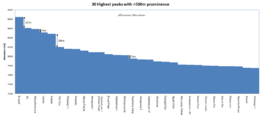
In 2010, Spanish climber Edurne Pasaban, became the first woman to summit all 14 eight-thousanders with no disputed climbing. In August 2011, Austrian climber Gerlinde Kaltenbrunner became the first woman to climb the 14 eight-thousanders without the use of supplementary oxygen.
The first couple and team who summited all 14 eight-thousanders together were the Italians Nives Meroi (second woman without supplementary oxygen), and her husband Romano Benet in 2017. The couple climbed alpine style, without the use of supplementary oxygen and other aids.
As of November 2018[update], the country with the most climbers to have climbed all 14 eight-thousanders is Italy with seven climbers, followed by Spain with six climbers, and South Korea with five climbers. Kazakhstan and Poland each have three climbers who have completed the "Crown of the Himalaya" (all 14 eight-thousanders).
On 29 October 2019, former Nepalese Gurka, and Special Boat Service (SBS) elite soldier Nirmal Purja, set a new speed record by climbing the 14 eight-thousanders in 6 months and 6 days, beating the previous record of just under 8 years.
List of 14
| Mountain | First ascent | First winter ascent | From 1950 to March 2012 | Climber Death Rate |
||||||||
|---|---|---|---|---|---|---|---|---|---|---|---|---|
| Peak | Height | Prom. | Isol. | Location | Date | Summiter(s) | Date | Summiter(s) | Total Ascents | Total Deaths | Deaths / Ascents | |
| Everest | 8,848 metres (29,029 ft) | 8,848 metres (29,029 ft) | undefined or infinite | 29 May 1953 | 17 February 1980 |
5656 | 223 | 3.9% | 1.52% | |||
| K2 | 8,611 metres (28,251 ft) | 4,020 metres (13,190 ft) | 1,315.6 kilometres (817.5 mi) | 31 July 1954 | on Italian expedition |
16 January
2021 |
306 | 81 | 26.5% | – | ||
| Kangchenjunga | 8,586 metres (28,169 ft) | 3,922 metres (12,867 ft) | 124.2 kilometres (77.2 mi) | 25 May 1955 | on British expedition |
11 January 1986 | 283 | 40 | 14.1% | 3.00% | ||
| Lhotse | 8,516 metres (27,940 ft) | 610 metres (2,000 ft) | 2.4 kilometres (1.5 mi) | 18 May 1956 | 31 December 1988 | 461 | 13 | 2.8% | 1.03% | |||
| Makalu | 8,485 metres (27,838 ft) | 2,378 metres (7,802 ft) | 17.2 kilometres (10.7 mi) | 15 May 1955 | on French expedition |
9 February 2009 | 361 | 31 | 8.6% | 1.63% | ||
| Cho Oyu | 8,188 metres (26,864 ft) | 2,344 metres (7,690 ft) | 27.7 kilometres (17.2 mi) | 19 October 1954 | 12 February 1985 | 3138 | 44 | 1.4% | 0.64% | |||
| Dhaulagiri I | 8,167 metres (26,795 ft) | 3,357 metres (11,014 ft) | 317.4 kilometres (197.2 mi) | 13 May 1960 | 21 January 1985 | 448 | 69 | 15.4% | 2.94% | |||
| Manaslu | 8,163 metres (26,781 ft) | 3,092 metres (10,144 ft) | 105.5 kilometres (65.6 mi) | 9 May 1956 | 12 January 1984 | 661 | 65 | 9.8% | 2.77% | |||
| Nanga Parbat | 8,125 metres (26,657 ft) | 4,608 metres (15,118 ft) | 187.9 kilometres (116.8 mi) | 3 July 1953 | on German–Austrian expedition |
26 February 2016 | 335 | 68 | 20.3% | – | ||
| Annapurna I | 8,091 metres (26,545 ft) | 2,984 metres (9,790 ft) | 33.7 kilometres (20.9 mi) | 3 June 1950 | on French expedition |
3 February 1987 | 191 | 61 | 31.9% | 4.05% | ||
| Gasherbrum I (Hidden Peak) |
8,080 metres (26,510 ft) | 2,155 metres (7,070 ft) | 23.4 kilometres (14.5 mi) | 5 July 1958 | 9 March 2012 | 334 | 29 | 8.7% | – | |||
| Broad Peak | 8,051 metres (26,414 ft) | 1,701 metres (5,581 ft) | 8.6 kilometres (5.3 mi) | 9 June 1957 | 5 March 2013 | 404 | 21 | 5.2% | – | |||
| Gasherbrum II | 8,034 metres (26,358 ft) | 1,524 metres (5,000 ft) | 5.3 kilometres (3.3 mi) | 7 July 1956 | 2 February 2011 | 930 | 21 | 2.3% | – | |||
| Shishapangma | 8,027 metres (26,335 ft) | 2,897 metres (9,505 ft) | 90.8 kilometres (56.4 mi) | 2 May 1964 | 14 January 2005 | 302 | 25 | 8.3% | ||||
Proposed expansion
In 2012, to relieve capacity pressure, overcrowding on the world’s highest mountain was tackled by placing greater restrictions on expeditions to the summit of Mount Everest. The move is a response to growing problems with litter, pollution and recent clashes between Sherpas and Western climbers. But, in an attempt to appease those hoping to conquer the 29,029 ft (8,848 m) tall peak, the Nepalese government is to open access to five other summits that sit over 26,247 ft (8,000 m) and develop climbing tourism. Nepal lobbied the International Climbing and Mountaineering Federation (or UIAA) to reclassify five summits (two on Lhotse and three on Kanchenjunga), as standalone eight-thousanders, while Pakistan lobbied for a sixth summit (on Broad Peak). The UIAA initiated in 2012 what it calls the ARUGA project with an aim to see if new 8,000 m (26,247 ft)-plus could feasibly achieve international recognition. Under that project, Nepal had tabled five new peaks and Pakistan had tabled one. In 2012, the UIAA set up a project group to consider the proposals called the AGURA Project. The six proposed summits for reclassification are subsidiary-summits of existing eight-thousanders, but which are also themselves above 8,000 m (26,247 ft) and have a prominence above 60 m (197 ft).
Proposed to the UIAA in 2012 for reclassification as standalone eight-thousanders.
| Proposed new eight-thousander | Height (m) |
Prominence (m) |
Dominance (Prom / Height) |
Dominance classification |
|---|---|---|---|---|
| Broad Peak Central | 8011 | 181 | 2,26 | B2 |
| Kangchenjunga W-Peak (Yalung Kang) | 8505 | 135 | 1,59 | C1 |
| Kangchenjunga S-Peak | 8476 | 116 | 1,37 | C2 |
| Kangchenjunga C-Peak | 8473 | 63 | 0,74 | C2 |
| Lhotse C-Peak I | 8410 | 65 | 0,77 | C2 |
| Lhotse Shar | 8382 | 72 | 0,86 | C2 |
| K 2 SW-Peak | 8580 | 30 | 0,35 | D1 |
| Lhotse C-Peak II | 8372 | 37 | 0,44 | D1 |
| Everest W-Peak | 8296 | 30 | 0,36 | D1 |
| Yalung Kang Shoulder | 8200 | 40 | 0,49 | D1 |
| Kangchenjunga SE-Peak | 8150 | 30 | 0,37 | D1 |
| K 2 P. 8134 (SW-Ridge) | 8134 | 35 | 0,43 | D1 |
| Annapurna C-Peak | 8013 | 49 | 0,61 | D1 |
| Nanga Parbat S-Peak | 8042 | 30 | 0,37 | D1 |
| Annapurna E-Peak | 7986 | 65 | 0,81 | C2 |
| Shisha Pangma C-Peak | 8008 | 30 | 0,37 | D1 |
| Everest NE-Shoulder | 8423 | 19 | 0,23 | D2 |
| Everest NE-Pinnacle III | 8383 | 13 | 0,16 | D2 |
| Lhotse N-Pinnacle III | 8327 | 10 | 0,12 | D2 |
| Lhotse N-Pinnacle II | 8307 | 12 | 0,14 | D2 |
| Lhotse N-Pinnacle I | 8290 | 10 | 0,12 | D2 |
| Everest NE-Pinnacle II | 8282 | 25 | 0,30 | D2 |
The proposed six new eight-thousander peaks would not meet the wider UIAA criteria of 600 m (1,969 ft) of elevation from nearest larger mountain's saddle, called topographic prominence, as used by the UIAA elsewhere for major mountains (the lowest prominence of the existing 14 eight-thousanders is Lhotse, at 610 metres (2,001 ft)). For example, only Broad Peak Central, with a topographic prominence of 181 metres (594 ft), would even meet the 150 metres (492 ft) prominence threshold to be a British Isles Marilyn. However, the appeal noted the UIAA's 1994 reclassification of Alpine four-thousander peaks, where a prominence threshold of 30 m (98 ft) was used, amongst other criteria; the logic being that if 30 m (98 ft) worked for 4,000 m (13,123 ft) summits, then 60 m (197 ft) is proportional for 8,000 m (26,247 ft) summits.
As of November 2018[update], there has been no conclusion by the UIAA and the proposals appear to have been set aside.
Climbers of all 14
There is no single undisputed source for verified Himalayan ascents; however, Elizabeth Hawley's The Himalayan Database, is considered as an important source for the Nepalese Himalayas. Online ascent databases pay close regard to The Himalayan Database, including the website AdventureStats.com, and the List. Various mountaineering journals, including the Alpine Journal and the American Alpine Journal, maintain extensive records and archives but do not always opine on ascents.
Verified ascents
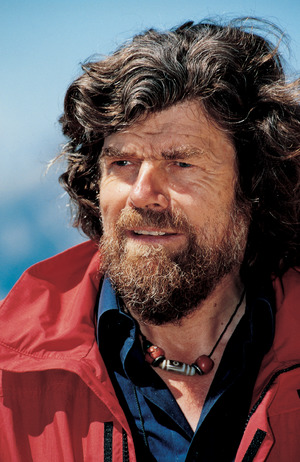
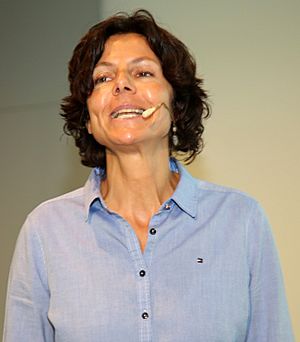
First male to have summited all 14 eight-thousanders, and first to do so without supplementary oxygen First female to have summited all 14 eight-thousanders; with supplementary oxygen First female to have summited all 14 eight-thousanders; no supplementary oxygen Fastest ascent of all 14 eight-thousanders Youngest person to climb all 14 eight-thousanders First disabled person to have summited all 14 eight-thousanders
The "No O2" column lists people who have climbed all 14 eight-thousanders without supplementary oxygen.
| Order | Order (No O2) |
Name | Period | Born | Age | Nationality |
|---|---|---|---|---|---|---|
| 1 | 1 | Reinhold Messner | 1972–1986 | 1944 | 42 | |
| 2 | Jerzy Kukuczka | 1979–1987 | 1948 | 39 | ||
| 3 | 2 | Erhard Loretan | 1982–1995 | 1959 | 36 | |
| 4 | Carlos Carsolio | 1985–1996 | 1962 | 33 | ||
| 5 | Krzysztof Wielicki | 1980–1996 | 1950 | 46 | ||
| 6 | 3 | Juanito Oiarzabal | 1985–1999 | 1956 | 43 | |
| 7 | Sergio Martini | 1983–2000 | 1949 | 51 | ||
| 8 | Park Young-seok | 1993–2001 | 1963 | 38 | ||
| 9 | Um Hong-gil | 1988–2001 | 1960 | 40 | ||
| 10 | 4 | Alberto Iñurrategi | 1991–2002 | 1968 | 33 | |
| 11 | Han Wang-yong | 1994–2003 | 1966 | 37 | ||
| 12 | 5 | Ed Viesturs | 1989–2005 | 1959 | 46 | |
| 13 | 6 | Silvio Mondinelli | 1993–2007 | 1958 | 49 | |
| 14 | 7 | Ivan Vallejo | 1997–2008 | 1959 | 49 | |
| 15 | 8 | Denis Urubko | 2000–2009 | 1973 | 35 | |
| 16 | Ralf Dujmovits | 1990–2009 | 1961 | 47 | ||
| 17 | 9 | Veikka Gustafsson | 1993–2009 | 1968 | 41 | |
| 18 | Andrew Lock | 1993–2009 | 1961 | 48 | ||
| 19 | 10 | João Garcia | 1993–2010 | 1967 | 43 | |
| 20 | Piotr Pustelnik | 1990–2010 | 1951 | 58 | ||
| 21 | Edurne Pasaban | 2001–2010 | 1973 | 36 | ||
| 22 | Abele Blanc | 1992–2011 | 1954 | 56 | ||
| 23 | Mingma Sherpa | 2000–2011 | 1978 | 33 | ||
| 24 | 11 | Gerlinde Kaltenbrunner | 1998–2011 | 1970 | 40 | |
| 25 | Vassily Pivtsov | 2001–2011 | 1975 | 36 | ||
| 26 | 12 | Maxut Zhumayev | 2001–2011 | 1977 | 34 | |
| 27 | Kim Jae-soo | 2000–2011 | 1961 | 50 | ||
| 28 | 13 | Mario Panzeri | 1988–2012 | 1964 | 48 | |
| 29 | Hirotaka Takeuchi | 1995–2012 | 1971 | 41 | ||
| 30 | Chhang Dawa Sherpa | 2001–2013 | 1982 | 30 | ||
| 31 | 14 | Kim Chang-ho | 2005–2013 | 1970 | 43 | |
| 32 | Jorge Egocheaga | 2002–2014 | 1968 | 45 | ||
| 33 | 15 | Radek Jaroš | 1998–2014 | 1964 | 50 | |
| 34/35 | 16/17 | Nives Meroi | 1998–2017 | 1961 | 55 | |
| 34/35 | 16/17 | Romano Benet | 1998–2017 | 1962 | 55 | |
| 36 | 18 | Peter Hámor | 1998–2017 | 1964 | 52 | |
| 37 | 19 | Azim Gheychisaz | 2008–2017 | 1981 | 37 | |
| 38 | Ferran Latorre | 1999–2017 | 1970 | 46 | ||
| 39 | 20 | Òscar Cadiach | 1984–2017 | 1952 | 64 | |
| 40 | Kim Mi-gon | 2000–2018 | 1973 | 45 | ||
| 41 | Sanu Sherpa | 2006–2019 | 1975 | 44 | ||
| 42 | Nirmal Purja | 2014–2019 | 1983 | 36 | ||
| 43 | Mingma Gyabu Sherpa | 2010–2019 | 1989 | 30 | ||
| 44 | Kim Hong-bin | 2006–2021 | 1964 | 57 |
Disputed ascents
Claims have been made for all 14 peaks in which not enough evidence was provided to verify the ascent. The disputed ascent in each claim is shown in parentheses. In most cases, the Himalayan chronicler Elizabeth Hawley is considered the definitive source regarding the facts of the dispute. Her The Himalayan Database is the source for other online Himalayan ascent databases (e.g. AdventureStats.com).
Cho Oyu is a recurrent problem peak as it is a small hump about 30 mins into the summit plateau, and the main proxy of a view of Everest, which is possible from the true summit, requires clear weather. Shishapangma is another problem peak because of its dual summits, which despite being close in height, are up to two hours climbing time apart. Hawley judged that Ed Viesturs had not reached the true summit, and he re-climbed the mountain to definitively establish his ascent.
Gallery
-
No. 1 – Everest
-
No. 2 – K2
-
No. 3 – Kangchenjunga
-
No. 4 – Lhotse
-
No. 5 – Makalu
-
No. 6 – Cho Oyu
-
No. 7 – Dhaulagiri
-
No. 8 – Manaslu
-
No. 9 – Nanga Parbat
-
No. 10 – Annapurna
-
No. 11 – Gasherbrum I
-
No. 12 – Broad Peak
-
No. 13 – Gasherbrum II
-
No. 14 – Shishapangma
Kangchenjunga
See also
 In Spanish: Ochomil para niños
In Spanish: Ochomil para niños
| Date | Name | Nationality | ||
|---|---|---|---|---|
| 17 May 2019 | Ivan Tomov | Cerebral edema | ||
| 17 May 2018 | Rustem Amirov | Altitude sickness | ||
| 19 May 2016 | Ang Furba Sherpa | Fall | ||
| 27 April 2015 | Hiroshi Yamagata | Avalanche (2015 Mount Everest avalanches) | ||
| 25 April 2015 | Zhen-Fang Ge | Avalanche (2015 Mount Everest avalanches) | ||
| 18 April 2014 | Asman Tamang | Avalanche (2014 Mount Everest ice avalanche) | ||
| 20 May 2013 | Hsiao-Shih Lee | Altitude sickness | ||
| 16 October 2012 | Temba Sherpa | Fall | ||
| 21 May 2012 | Milan Sedláček | Exhaustion | ||
| 7 May 2010 | Sergey Duganov | Altitude sickness | ||
| 25 May 2009 | Sergey Samoilov | Fall | ||
| 21 May 2007 | Pemba Doma | Fall | ||
| 9 May 2006 | Pavel Kalný | Fall | ||
| 5 October 2003 | Sun-dug Hwang | Avalanche (on Lhotse Shar) | ||
| 5 October 2003 | Joo-hoon Park | Avalanche (on Lhotse Shar) | ||
| 17 September 2000 | Vladimir Bondarev | Avalanche | ||
| 27 May 1997 | Vladimir Bashkirov | Illness | ||
| 24 October 1989 | Jerzy Kukuczka | Fall | ||
| 27 September 1987 | Antoni (Toni) Sors | Avalanche (on Lhotse Shar) | ||
| 27 September 1987 | Sergio Escalera | Avalanche (on Lhotse Shar) | ||
| 27 September 1987 | Francesc Porras | Avalanche (on Lhotse Shar) | ||
| 27 September 1987 | Antonio Quiñones | Avalanche (on Lhotse Shar) | ||
| 14 September 1987 | Czesław Jakiel | Avalanche | ||
| 30 October 1986 | Pedro Alonso | Fall (on Lhotse Shar) | ||
| 25 October 1985 | Rafał Chołda | Fall | ||
| 16 October 1981 | Philippe Petten | Disappearance (on Lhotse Shar) | ||
| 16 October 1981 | Pierre Favez | Disappearance (on Lhotse Shar) |



